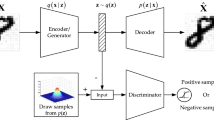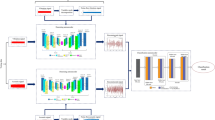Abstract
An important demand in the machinery environment is the frequent handling of variant faults occurring during active performance of motors and gearbox and through its vibrational signals. Accordingly, effective intelligent approaches detecting and treating causes of low productivity, reliability and higher maintenance cost have been introduced. A huge attention in recent years recommended deep learning and reports higher capabilities in this context. However, one limitation of using the deep learning is that its performance (in terms of evaluation matrices and/or over-fitting) is highly connected to the availability of large number of training samples as it learns by examples. This paper tackles this problem, proposing novel generative adversarial networks based augmentation method to balance the dataset and hence increase generalizability of the machine learning model. The generator of the generative adversarial networks method provides more samples with main objective of class balancing. Its discriminator recognizes the real and fake samples and assigns classes to the inputs as well. Accompanying deep framework based on the pervious augmentation method and a two subsequent unsupervised sparse autoencoders is also proposed to develop accurate intelligent identification model for motor and gearbox multi-faults with 10 classes. Precision, recall, and F1 measures proved the validity of the proposed augmentation when evaluated on the dataset of gear and motor signals and enhanced the class balancing. In addition, it enhances results of deep learning and reports identification accuracy of 93.7%.













Similar content being viewed by others
Data availability
Data available on request from the authors.
References
Choudhary A, Goyal D, Shimi SL, Akula A (2018) Condition monitoring and fault diagnosis of induction motors: a review. Arch Comput Methods Eng 26:1221–1238
Agrawal V, Panigrahi B, Subbarao P (2015) Review of control and fault diagnosis methods applied to coal mills. Process Control 32:138–153
Bolón-Canedo V, Sánchez-Maroño N, Alonso-Betanzos A (2013) A review of feature selection methods on synthetidata. Knowl Inf Syst 34:483–519
Lei Y, Yang B, Jiang X, Jia F, Li N, Nandi AK (2020) Applications of machine learning to machine fault diagnosis: a review and roadmap. Mech Syst Signal Process 138:106587
Nandi S, Toliyat HA, Li X (2005) Condition monitoring and fault diagnosis of electrical motors—a review. IEEE Trans Energy Convers 20:719–729
Xue X, Zhou J, Xu Y, Zhu W, Li C (2015) An adaptively fast ensemble empirical mode decomposition method and its applications to rolling element bearing fault diagnosis. Mech Syst Signal Process 62:444–459
Pan L, Zhu D, She S, Song A, Shi X, Duan S (2018) Gear fault diagnosis method based on wavelet-packet independent component analysis and support vector machine with kernel function fusion. Adv Mech Eng 10(11):1–10
Zair M, Rahmoune C, Benazzouz D (2019) Multi-fault diagnosis of rolling bearing using fuzzy entropy of empirical mode decomposition, principal component analysis, and SOM neural network. Proc Inst Mech Eng Part C J Mech Eng Sci 233:3317–3328
Cerrada M, Sanchez R, Cabrera D, Zurita G, Li C (2015) Multi-stage feature selection by using genetic algorithms for fault diagnosis in gearboxes based on vibration signal. Sensors 15:23903–23926
Yun JX (2011) Fault diagnosis for rolling bearing on genetic-SVM classifier. Adv Mater Res 199:620–624
Huang R, Liao Y, Zhang S, Li W (2019) Deep decoupling convolutional neural network for intelligent compound fault diagnosis. IEEE Access 7:1848–1858
Zhu X, Hou D, Zhou P, Han Z, Yuan Y, Zhou W, Yin Q (2019) Rotor fault diagnosis using a convolutional neural network with symmetrized dot pattern images. Measurement 138:526–535
Guan Z, Liao Z, Li K, Chen P (2019) A precise diagnosis method of structural faults of rotating machinery based on combination of empirical mode decomposition, sample entropy, and deep belief network. Sensors 19(3):591
Du W, Zhou J, Wang Z, Li R, Wang J (2018) Application of improved singular spectrum decomposition method for composite fault diagnosis of gear boxes. Sensors 18:3804
Wang Z, Wang J, Du W (2018) Research on fault diagnosis of gearbox with improved vibrational mode decomposition. Sensors 18:3510
Chen X, Cheng G, Li H, Li Y (2017) Research of planetary gear fault diagnosis based on multi-scale fractal box dimension of ceemd and elm. Strojniski Vestnik J Mech Eng 63:45–55
Li X, Zhang W, Ding Q (2018) Cross-domain fault diagnosis of rolling element bearings using deep generative neural networks. IEEE Trans Ind Electron 66:5525–5534
Xiang Z, Zhang X, Zhang W, Xia X (2019) Fault diagnosis of rolling bearing under fluctuating speed and variable load based on tco spectrum and stacking autoencoder. Measurement 138:162–174
Ando S, Huang CY (2017) Deep oversampling framework for classifying imbalanced data. Proc Mach Learn Knowl Discov Databases 66:770–785
Garca S, Zhang ZL, Altalhi A, Alshomrani S, Herrera F (2018) Dynamic ensemble selection for multi-class imbalanced datasets. Inf Sci 445:22–37
Radford A, Metz L, Chintala S (2016) Unsupervised representation learning with deep convolutional generative adversarial networks. Proc ICLR 66:1–16
Douzas G, Bacao F (2018) Effective data generation for imbalanced learning using conditional generative adversarial networks. Expert Syst Appl 91:464–471
Mullick SS, Datta S, Das S (2019) Generative adversarial minority oversampling. In: Processing of IEEE/CVF international conference on computer vision (ICCV), pp 1695–1704
Eren L (2017) Bearing fault detection by one-dimensional convolutional neural networks. Math Probl Eng 2017:9
Jiang G, He H, Yan J, Xie P (2019) Multiscale convolutional neural networks for fault diagnosis of wind turbine gearbox. IEEE Trans Ind Electron 66:3196–3207
Gryllias KC, Antoniadis IA (2012) A support vector machine approach based on physical model training for rolling element bearing fault detection in industrial environments. Eng Appl Artif Intell 25(2):326–344
Li Z, Yan X, Yuan C, Peng Z, Li L (2011) Virtual prototype and experimental research on gear multi-fault diagnosis using wavelet-autoregressive model and principal component analysis method. Mech Syst Signal Process 25:2589–2607
Janakiraman V, Nguyen X, Assanis D (2013) Nonlinear identification of a gasoline HCCI engine using neural networks coupled with principal component analysis. Appl Soft Comput 13:2375–2389
Appana DK, Prosvirin A, Kim J-M (2018) Reliable fault diagnosis of bearings with varying rotational speeds using envelope spectrum and convolution neural networks. Soft Comput 22:6719–6729
Guo S, Yang T, Gao W, Zhang C (2018) A novel fault diagnosis method for rotating machinery based on a convolutional neural network. Sensors 18:1429
Pandhare V, Singh J, Lee J (2019) Convolutional neural network based rolling-element bearing fault diagnosis for naturally occurring and progressing defects using time-frequency domain features. In: Proceedings of the prognostics and system health management conference, pp 320–326
Jiang G, He H, Xie P, Tang Y (2017) Stacked multilevel-denoising autoencoders: a new representation learning approach for wind turbine gearbox fault diagnosis. IEEE Trans Instrum Meas 66:2391–2402
Liu G, Bao H, Han B (2018) A stacked autoencoder-based deep neural network for achieving gearbox fault diagnosis. Math Problems Eng 2018:10
Goodfellow I, Pouget-Abadie J, Mirza M, Xu B, Warde-Farley D, Ozair S, Courville A, Bengio Y (2014) Generative adversarial networks. Adv Neural Inf Process Syst 27:2672–2680
Mao W, Liu Y, Ding L, Li Y (2019) Imbalanced fault diagnosis of rolling bearing based on generative adversarial network: a comparative study. IEEE Access 7:9515–9530
Lee YO, Jo J, Hwang J (2017) Application of deep neural network and generative adversarial network to industrial maintenance: a case study of induction motor fault detection. In: Proceedings of the IEEE international conference big data, pp 3248–3253
Liu H, Zhou J, Xu Y, Zheng Y, Peng X, Jiang W (2018) Unsupervised fault diagnosis of rolling bearings using a deep neural network based on generative adversarial networks. Neurocomputing 315:412–424
Han T, Liu C, Yang W, Jiang D (2019) A novel adversarial learning framework in deep convolutional neural network for intelligent diagnosis of mechanical faults. Knowl Based Syst 165:474–487
Frini M, Soualhi A, Badaoui M, Marrakchi G (2017) Gear fault detection using the geometric properties of electrical currents in three-phase induction motor-based systems. Condition Monit 7(2):47–52
JF Lea Jr, L Rowlan (2019) Use of beam pumps to deliquefy gas wells, gas well deliquification, 3rd ed. sciencDirect, Elsevier
Liang X, Zuo MJ, Feng Z (2018) Dynamic modeling of gearbox faults: a review. Mech Syst Signal Process 98:852–876
Schwack F, Stammler M, Poll G, Reuter A (2016) Comparison of life calculations for oscillating bearings considering individual pitch control in wind turbines. J Phys Conf Ser 753(11):112013
Seo B, Sung S, Kang K, Song J, Jang G (2016) Unbalanced magnetic force and cogging torque of PM motors due to the interaction between PM magnetization and stator eccentricity. Micro Syst Technol 22:1249–1255
Fan C, Syu J, Pan M, Tsao W (2011) Study of start-up vibration response for oil whirl, oil whip and dry whip. Mech Syst Signal Process 25(8):3103–31115
Singhal S, Mistry R (2009) Oil whirl rotor dynamic instability phenomenon-diagnosis and cure in large induction motor. Proc Ind Appl Soc 66:14–16
P Dang, L Do, N Vo, T Ngo, H Le (2019) Identification of unbalance in rotating machinery using vibration analyse solution. In: 4th International conference on mechatronics and electrical systems, p 841
Jung J, Lee SB, Lim C, Cho C, Kim K (2016) Electrical monitoring of mechanical looseness for induction motors with sleeve bearings. IEEE Trans Energy Convers 31(4):1377–1386
Verma A, Sarangi S, Kolekar MH (2014) Experimental investigation of misalignment effects on rotor shaft vibration and on stator current signature. Fail Anal Prev 14:125–138
Patidar L, Rao KU (2012) Soft foot and motor problem solved through predictive maintenance approach. Proc Recent Trends Eng Sci 66:20–21
Majid S, Nikravesh Y, Goudarzi MD (2017) A review paper on looseness detection methods in bolted structures. Latin Am J Solids Struct 14:2153–2176
Qiao Z, Lei Y, Li N (2019) Applications of stochastic resonance to machinery fault detection: a review and tutorial. Mech Syst Signal Process 122:502–536
Plante T, Nejadpak A, Yang CX (2015) Faults detection and failures prediction using vibration analysis. Proc IEEE Autotestcon 66:227–231
Sohaib M, Kim J-M (2018) Reliable fault diagnosis of rotary machine bearings using a stacked sparse autoencoder-based deep neural network. Shock Vib 2018:66
Nath AG, Sharma A, Udmale SS, Singh SK (2021) An early classification approach for improving structural rotor fault diagnosis. IEEE Trans Instrum Meas 70:1–13
Sun N, Mo X, Wei T, Zhang D, Luo W (2020) The effectiveness of noise in data augmentation for fine-grained image classification. In: ACPR 2019. Lecture notes in computer science, vol 12046. Springer, Cham, pp 779–792
Helwan A, Ozsahin DU (2017) Sliding window based machine learning system for the left ventricle localization in MR cardiac images. Appl Comput Intell Soft Comput 66:1–9
Lashgari E, Liang D, Maoz U (2020) Data augmentation for deep-learning-based electroencephalography. J Neurosci Methods 346:108885
Acknowledgements
The authors extend their appreciation to the Deputyship for Research & Innovation, Ministry of Education in Saudi Arabia for funding this research work through the project number RI-44-0224.
Author information
Authors and Affiliations
Corresponding author
Ethics declarations
Conflict of interest
The authors declare no conflict of interest.
Additional information
Publisher's Note
Springer Nature remains neutral with regard to jurisdictional claims in published maps and institutional affiliations.
Rights and permissions
Springer Nature or its licensor (e.g. a society or other partner) holds exclusive rights to this article under a publishing agreement with the author(s) or other rightsholder(s); author self-archiving of the accepted manuscript version of this article is solely governed by the terms of such publishing agreement and applicable law.
About this article
Cite this article
Karamti, H., Lashin, M.M.A., Alrowais, F. et al. Accompanying deep framework for faults in motor and gearbox with disproportion vibrational samples. Neural Comput & Applic 35, 7659–7676 (2023). https://doi.org/10.1007/s00521-022-08020-8
Received:
Accepted:
Published:
Issue Date:
DOI: https://doi.org/10.1007/s00521-022-08020-8




